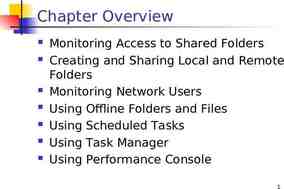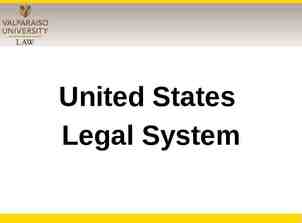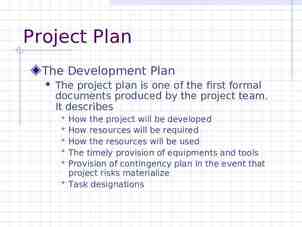The Professional Services Category of the Acquisition
43 Slides312.20 KB
The Professional Services Category of the Acquisition Gateway Introduces A Spotlight Presentation Organizational Conflict of Interest 101 1
Housekeeping To Download Presentation and other files – Click on the file you’d like to download. Make sure that it’s highlighted in blue after click the file to download – Then select “Download File(s)” 2
Housekeeping – Have Questions? Click in the “Q&A” section on the right side of your screen Type your question into the comment box Click send 3
Housekeeping – Webinar Materials Webinar materials will be emailed to attendees, within the next 2 weeks, including: – Presentation slides – Q&As – CLP certificate (if you registered) All questions may not be answered during the session, if this is the case, we will provide these Q&A responses in the email to you. A copy of the presentation will be on the Acquisition Gateway (https://hallways.cap.gsa.gov), Professional Services Hallway once it has been made 508 compliant. 4
HOUSEKEEPING - CLP To Receive CLP Enter your email address Registered users will receive a certificate within two weeks of training via email 5
OCI 101 Basic Principles Eve Lyon NASA HQ 6
Background Created as policy by DoD in 1963; remained essentially same since 1968 – Places all duties on the CO to protect the Government Changed landscape – Purchasing more services than supplies – Relying more on outside expertise – Consolidating among companies reduces number of contractors Issue to overturn award since mid-1990’s creating case law (read new policy) – Created case law different from 9.5 and is ever evolving – Made OCI popular grounds for protest – Treat primarily as a potential protest issue 7
Basic Duties Identify OCI – Considered the most important of the duties Resolve OCI – Award contract when all OCIs are acceptably resolved – Standard of review changed from deferring to the CO judgement to careful examination of factual analysis whether identification and resolution reasonable 8
Identify 9
What is an OCI? Involves two contracts (or potential of two contracts) the performance of which creates: – Unfair Competitive Advantage and/or – Bias Does not mean contractor has done something “bad” Requires hard facts Differs from Personal Conflicts of Interest Remember: Contractor includes affiliates. Affiliate interests imputed to the contractor 10
Where Is Discussion about 9.5? Subpart 9.5 relies on definition, principles, and examples. Section 9.505 describes typical conflicts. Section 9.508 contains additional examples. Case Law relies on principles in subpart 9.5, but creates tests not in subpart 9.5. 11
Hard Facts Turner Construction Company, Inc. v. United States, 645 F.3d 1377 (Fed. Cir. 2011) – Effects identification – Requires conflicts be based on hard facts not inferences/suspicion and innuendo – Harm presumed once hard facts establish existence of conflict Harm can be rebutted particular with unequal access to information – Changes the FAR regarding conflicts based on appearance Difference between appearance and a potential conflict 9.5 designed to prevent actual and potential conflicts 12
Biased Ground Rules Serious: Involves both unfair competitive advantage and bias – Could affect the Government’s ability to procure best value – Could affect offerors’ ability to compete on level playing field Test: Was a firm in a position to skew the competition, whether intentionally or not, in favor of itself? Situations: – Evaluating proposals – Writing draft PWS – Preparing a study Occurs early in process May be able to mitigate if conflict – Supporting Source Board Use of subjective judgment may or may not be present Involves Unequal Access to Source Selection Info 13
Impaired Objectivity Garden Variety: Involves bias Test – Use of subjective judgment and – Able to affect other financial interest – Occurs with acquisition of services Examples of objective judgment: Painting, Maintaining hardware, Performing facilities services, Providing training Examples of subjective judgment: Analyze, Study, Recommend, Develop strategies, Advise – Key indicators are: Required level of education (more education/more likely use subjective judgement) Use of key personnel clause Case law does not distinguish between impaired objectivity and biased ground rules for purposes of resolution 14
Unequal Access to Information Ubiquitous/in most contracts: Involves unfair competitive advantage FAR: Unrestricted access providing unfair competitive advantage when: – Performance of contract provides contractor with access to another contractor’s proprietary information – Performance of contract gives contractor access to nonpublic information about competitive acquisition Test from case law – Whether information was nonpublic information – Whether awardee had access to nonpublic information – Whether access to nonpublic information afforded an unfair competitive advantage Case law presumes harm was hard facts establish conflict exists – Presence of barriers/NDA’s can rebut presumption – Case law suggest need to examine whether barriers/NDA breached 15
Expansion Health Net Federal Services, B-401652.3, B-401652.5, November 4, 2009, 2009 CPD ¶ 220 – Involves section 3.101-1 not FAR 9.5 – Involves former Government employee Obtains valuable Source Selection information while government employee Is in a position to use nonpublic information while contractor employee, i.e., working on proposal – Held knowledge is presumed used, i.e., cannot erect a firewall in one’s brain – Acts as a type of restriction on post-employment – Some decisions conflates with unequal access to information 16
Natural versus Unnatural OCI principles protect against unnatural competitive advantage – Unnatural because not of contractor’s making – Biased Ground Rule and Unequal Access to Information Natural competitive advantage developed by contractor – There is no need to balance natural competitive advantage – Experience gained because incumbent Unequal Access to Information – Access to another contractor’s overhead rates or source selection information developed by Government is unnatural competitive advantage – Access to nonpublic technical data developed in performance of a Government contract is a natural competitive advantage 17
Resolve 18
Types of Resolution* Avoid Neutralize Mitigate Waive * Not defined in 9.5 or case law 19
Avoidance Done by the Government before release of RFP – Remove part of SOW creating OCI, finding another way to have the requirement filled – Use more than one contractor to prepare a SOW Does not apply once RFP released – Screening orders under IDIQ contract is not avoidance 20
Neutralize Prevents the contractor from participating in the follow on contract Involves the use of clause “Limitation on Future Contracting” – Describe nature of the conflict/limitation – State duration of the limitation Appears to be the most common resolution envisioned by 9.5 Clause not in FAR, but in NFS 21
Neutralize Used frequently to resolve biased ground rules, e.g., prevents contractor from establishing ground rules then from participating in follow-on competition Can be used with impaired objectivity when receipt of unbiased advice part of the requirement, e.g., standing review boards Able to require according to section 9.507-1 Rejected by most contractors – Second contract much larger than contract developing RFP or supporting Acquisition planning – Support contractors now consolidated with manufacturing contractors 22
Mitigation Reduces the conflict to an acceptable level Used most often as method of resolution Involves a mitigation plan – Details contractor’s responsibility – * Include clause similar to one in NASA OCI Guide Clause incorporates the mitigation plan in the contract, making it a contract requirement 23
Types of Mitigation Firewalls – Requires contractor control information within the part of the business performing the effort – Works best to resolve conflicts involving Unequal Access to Information – Fails to resolve conflicts based on bias – Favored by contractors Dissemination of information – Allows the Government to provide data to all potential offerors – Designed to lessen unfair competitive advantage: unequal access to information and biased ground rules – Ensure Government has rights – May be available when “biased ground rule” OCI involving study very early in process Informs other offerors about study Provides an opportunity to comment 24
Types of Mitigation Use of a nonconflicted party – Allows a party without the conflict to perform the requirement creating the OCI – Requires use of a firewall between the parties – May result in a change to the technical and price proposal – Used best when nonconflicted party is a prime Firewall bars prime from overseeing subcontractor when prime is conflicted party – Used often Restrict transfer of personnel – Done when unfair access involves Source Selection info – Restricts employees with unfair access from working/assisting on proposal Combine methods of mitigation, e.g., monitoring by Government Accept all plausible forms of mitigation 25
Mitigation: Unequal Access to Data Firewall preferred method to resolve this OCI. – 9.505-4 states conflict exists “unless restrictions are imposed” * Restrictions are requirement of a contract – NASA has NFS 1852.237-72, ”Access to Sensitive Information.” – DoD has DFARS 252.227-7025, “Limitations on the Use or Disclosure of Government-Furnished Information Marked with Restrictive Legends” 26
Waiver Allows agency to determine application of Subpart 9.5 “in a particular situation would not be in the Government interest” – Will not resolve the OCI – Should use to waive “residual” OCIs, e.g., biased OCI mitigated with firewall Must be in writing Must set forth extent of the conflict – Must be “knowing” waiver Done by the Government Approved no lower than HCA Upheld by GAO and the court – Allowed after protest is filed, but protester can challenge reasonableness and completeness – * Use when litigating OCI allegation that seems remote or the contracting officer believes harm from OCI is acceptable 27
IDIQ Contracts FAR requires all conflicts be resolved prior to award of contract Nature of the order not known until placed * Work around in mitigation plan: – Requires contractor review all orders for conflicts – Requires contractor suggest resolution for orders with OCIs – Should include a waterfall approach describing multiple types of resolution from the least onerous to the most onerous, e.g., starts with a firewall and ends with Limitation on Future Contracting when other types of resolution not available – Ensure contracting officer is part of process Agrees conflict exists Agrees resolution is acceptable 28
Best Practices 29
Identify OCI * Start with acquisition planning – Identify whether OCI may be created – Think about how difficult resolution will be * Conduct early communications with industry – Explain how requirements may create OCI – Establish ground rules for OCI – Ask industry to provide comments; have industry read NASA OCI Guide * Expect some communications with industry to be one-onone – Volunteer to provide offeror an initial assessment – Explain initial assessment is not binding * Provide written responses to DRFP Respond to any question on OCI – Creates a presumption OCI exists if CO fails to respond * Blue is best practice/black is required 30
OCI Provision FAR 9.507 requires provision when OCI is identified, which states: – The nature of the potential conflict as seen by the contracting officer: – The nature of the proposed restraint upon future contractor activities; (done when the resulting contract would create an OCI) – Whether or not the terms of any proposed clause and application are subject to negotiation No standard provision given the fact intense nature of conflicts * Use solicitation provision similar one in NASA OCI Guide which identifies the OCI and asks the offerors identify and propose methods to OCIs 31
Responses from Offerors * Require offerors to identify whether OCI exists * Require offerors to proposed method to resolve OCI * Understand: Offerors in best position to know their financial interests * Understand: Government in best position to know when requirement could create an OCI *Understand each offeror may have different OCIs 32
Responses from Offerors Cannot rely solely on the information provided by the offerors – Set forth by case law – Trust, but verify, e.g., check offerors’ web site? Do not have to accept the suggested method to resolve OCI Can disagree with identification and/or proposed resolution of OCIs Remember, offerors will have different conflicts. – Different financial interests – Different earlier contracts Suggest using solicitation provision similar one in NASA OCI Guide to require offerors identify and propose methods to OCIs 33
Take Aways Know your OCIs – Biased Ground Rules: Serious; Government controls the facts – Impaired Objectivity: Common; only affect Government’s interest – Unequal Access to Information: Easiest to resolve Know your methods to resolve – – – – Avoid Neutralize Mitigate Waive Use this knowledge – Identify OCI’s as early as possible – Communicate by identifying OCI’s in RFP and establishing ground rules in RFP 34
Backup 35
NASA OCI Guide Found at https://www.hq.nasa.gov/office/procurement/OCIGuide.pd f Explains principles on identification and resolution Discusses best practices Contains model provision, clauses, and DRD requirements Written in 2008 36
Case Law Aetna Government Health Plans, Inc., B-254397-16, et al., July 27, 1995, 95-2 CPD ¶ 129 – Contracting officer’s responsibility to assess whether a potential conflict exists and in developing appropriate ways to resolve it exercising “common sense, good judgment, and sound discretion.” – Describes the three types of organizational conflicts of interest addressed by FAR Subpart 9.5. – States “there is no basis to distinguish between firms and its affiliates, at least where the concern about potentially biased ground rules and impaired objectivity are at issues.” – Holds that a firewall is virtually irrelevant to an organizational conflict of interest involving potential impaired objectivity. 37
Case Law Social Impact, Inc., B-412941; B-412941.2, July 8, 2016 2016 CPD ¶ 203 – Evidences a higher level of scrutiny regarding the resolution of a conflict. – Applies a fact-specific inquiry into the identification and resolution of conflicts before determining there is an absent clear evidence that the agency’s conclusion is unreasonable. 38
Case Law PURVIS Systems, Inc., B-293807.3, B-293807.4, August 16, 2004, 2004 CPD ¶ 177 – Test for impair objectivity: Use of subjective judgement and conflicting financial interest. – An “impaired objectivity” OCI is created when a contractor’s judgment and objectivity performance of a contract may be impaired due to the fact that substance of the contractor’s performance has the potential to affect other interests of the contractor. – Classic example: When the company responsible for assessing the performance of systems also has manufactured the system 39
Case Law ARINC Engineering Services, LLC. V. United States and BAE Systems Analytical Solutions, 77 Fed. 196, 2007 U.S. Claims LEXIS 205 (2007) Establishes the test for “unfair access to data” – Whether an offeror had access to nonpublic information that was unavailable to the protester – Whether that nonpublic information was competitively useful in responding to the solicitation* – Whether, by having unequal access to that information, the awardee was afforded an advantage that was unfair * Now whether the information was nonpublic. 40
Case Law AT&T Research, B-412187, July 28, 2016, 2016 CPD ¶ 237. – Expands on hard facts needed to establish an OCI based on unequal access to information Affirms use is presumed without hard facts. Presumption may be rebutted by hard facts. Lack of glaring evidence of use is not a hard fact Mitigation efforts screening or walling off certain individuals to prevent an improper disclosure of information, may be hard facts, i.e., an effective means to address an unequal access to information OCI. BAE Systems Technology Solutions & Services, Inc., B411810.3 June 24, 2016, 2016 CPD ¶ 168 – Signed NDAs adequate mitigation in the absence of hard facts showing NDAs failed to prevent an unfair competitive advantage 41
Case Law Systems Made Simple, Inc. B-412948.2, July 20, 2016, 2016 CPD ¶ 207. – Excellent example when contractor’s early involvement in a study does not constitute an OCI based on biased ground rules – Reaffirms using two sources for recommendations can be basis to deny allegations of OCI based on biased ground rules – “Textbook” analysis by contracting officer Concurrent Technologies Corp., B-412795.2, B412795.3, Jan.17, 2017, 2016 CPD ¶ 15 – Case upholds validity of waivers consistent with the FAR. – Case does excellent job of explaining the requirements for waiver to 9.5. 42
Case Law A Squared Joint Venture, B-413139; B-413139.2, August 23, 2016, 2016 CPD ¶ 243 – Holds decisions on OCI are ground rules of a competition – Requires offerors to file no later than proposal submission – Fosters early communication with industry about OCI decisions – Enjoins issue early, limiting use of OCI as a sword to challenge selection – Examples: Determination why an contractor’s early involvement does not constitute bias ground rules, e.g., early study Determination regarding interrelated contracts. 43
















































